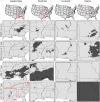Thriving in the Cold: Glacial Expansion and Post-Glacial Contraction of a Temperate Terrestrial Salamander (Plethodon serratus)
- PMID: 26132077
- PMCID: PMC4488858
- DOI: 10.1371/journal.pone.0130131
Thriving in the Cold: Glacial Expansion and Post-Glacial Contraction of a Temperate Terrestrial Salamander (Plethodon serratus)
Abstract
The dynamic geologic history of the southeastern United States has played a major role in shaping the geographic distributions of amphibians in the region. In the phylogeographic literature, the predominant pattern of distribution shifts through time of temperate species is one of contraction during glacial maxima and persistence in refugia. However, the diverse biology and ecology of amphibian species suggest that a "one-size-fits-all" model may be inappropriate. Nearly 10% of amphibian species in the region have a current distribution comprised of multiple disjunct, restricted areas that resemble the shape of Pleistocene refugia identified for other temperate taxa in the literature. Here, we apply genetics and spatially explicit climate analyses to test the hypothesis that the disjunct regions of these species ranges are climatic refugia for species that were more broadly distributed during glacial maxima. We use the salamander Plethodon serratus as a model, as its range consists of four disjunct regions in the Southeast. Phylogenetic results show that P. serratus is comprised of multiple genetic lineages, and the four regions are not reciprocally monophyletic. The Appalachian salamanders form a clade sister to all other P. serratus. Niche and paleodistribution modeling results suggest that P. serratus expanded from the Appalachians during the cooler Last Glacial Maximum and has since been restricted to its current disjunct distribution by a warming climate. These data reject the universal applicability of the glacial contraction model to temperate taxa and reiterate the importance of considering the natural history of individual species.
Conflict of interest statement
Figures





Similar articles
-
Phylogeographic and demographic effects of Pleistocene climatic fluctuations in a montane salamander, Plethodon fourchensis.Mol Ecol. 2009 May;18(10):2243-62. doi: 10.1111/j.1365-294X.2009.04164.x. Epub 2009 Apr 14. Mol Ecol. 2009. PMID: 19389165
-
Testing nested phylogenetic and phylogeographic hypotheses in the Plethodon vandykei species group.Syst Biol. 2004 Oct;53(5):781-92. doi: 10.1080/10635150490522296. Syst Biol. 2004. PMID: 15545255
-
Persistence across Pleistocene ice ages in Mediterranean and extra-Mediterranean refugia: phylogeographic insights from the common wall lizard.BMC Evol Biol. 2013 Jul 11;13:147. doi: 10.1186/1471-2148-13-147. BMC Evol Biol. 2013. PMID: 23841475 Free PMC article.
-
Plant molecular phylogeography in China and adjacent regions: Tracing the genetic imprints of Quaternary climate and environmental change in the world's most diverse temperate flora.Mol Phylogenet Evol. 2011 Apr;59(1):225-44. doi: 10.1016/j.ympev.2011.01.012. Epub 2011 Feb 1. Mol Phylogenet Evol. 2011. PMID: 21292014 Review.
-
Phylogeographic insights into cryptic glacial refugia.Trends Ecol Evol. 2008 Oct;23(10):564-71. doi: 10.1016/j.tree.2008.06.010. Epub 2008 Aug 21. Trends Ecol Evol. 2008. PMID: 18722689 Review.
Cited by
-
Updated range map of an endangered salamander and congeneric competitor reveals different niche preferences.Ecol Evol. 2024 May 20;14(5):e11262. doi: 10.1002/ece3.11262. eCollection 2024 May. Ecol Evol. 2024. PMID: 38774147 Free PMC article.
-
Climate change models predict decreases in the range of a microendemic freshwater fish in Honduras.Sci Rep. 2020 Jul 29;10(1):12693. doi: 10.1038/s41598-020-69579-7. Sci Rep. 2020. PMID: 32728139 Free PMC article.
-
Contributions of ancestral inter-species recombination to the genetic diversity of extant Streptomyces lineages.ISME J. 2016 Jul;10(7):1731-41. doi: 10.1038/ismej.2015.230. Epub 2016 Feb 5. ISME J. 2016. PMID: 26849310 Free PMC article.
-
Pleistocene to holocene expansion of the black-belt cichlid in Central America, Vieja maculicauda (Teleostei: Cichlidae).PLoS One. 2017 May 30;12(5):e0178439. doi: 10.1371/journal.pone.0178439. eCollection 2017. PLoS One. 2017. PMID: 28558052 Free PMC article.
-
Genome-Scale Data Reveal Deep Lineage Divergence and a Complex Demographic History in the Texas Horned Lizard (Phrynosoma cornutum) throughout the Southwestern and Central United States.Genome Biol Evol. 2022 Jan 4;14(1):evab260. doi: 10.1093/gbe/evab260. Genome Biol Evol. 2022. PMID: 34849831 Free PMC article.
References
-
- Avise JC. Toward a regional conservation genetics perspective: phylogeography of faunas in the southeastern United States In: Avise JC, L HJ, editors. Conservation Genetics: Case Histories from Nature. New York: Chapman and Hall; 1996. p. 431–70.
-
- Kozak KH, Blaine RA, Larson A. Gene lineages and eastern North American palaeodrainage basins: phylogeography and speciation in salamanders of the Eurycea bislineata species complex. Mol Ecol. 2006. January;15(1):191–207. - PubMed
-
- Soltis DE, Morris AB, McLachlan JS, Manos PS, Soltis PS. Comparative phylogeography of unglaciated eastern North America. Mol Ecol. 2006. December;15(14):4261–93. - PubMed
-
- Swenson NG, Howard DJ. Clustering of contact zones, hybrid zones, and phylogeographic breaks in North America. Am Nat. 2005. November;166(5):581–91. - PubMed
Publication types
MeSH terms
LinkOut - more resources
Full Text Sources
Other Literature Sources

